柑橘是世界第一大宗水果,按种类主要包括宽皮柑橘、橙类、柚类、柠檬和金柑五大类[1]。柚属芸香科柑橘属植物,是一类果实硕大、果肉晶莹脆嫩、营养丰富、风味清香独特、耐贮运的柑橘品种[2]。柚类在我国品种多样,资源丰富,主要栽培品种有琯溪蜜柚、沙田柚、文旦柚。我国柚类产量达598.28 万吨,占总柑橘产量的13.05%(2019 年),其中70%为琯溪蜜柚[3]。促进人类健康一直是科学研究的重点,柚果因其独特的感官特性以及高价植的营养功能,以及对柚果果实营养成分的探索受到越来越多的关注,包括糖、维生素C、类黄酮[4]、酚酸[5]、类柠檬苦素[6]、香豆素[7-8]、挥发性物质等多种营养成分[9]。这些物质不仅能为人体的生命活动提供基本的能量和营养,而且对糖尿病、心血管[10]、骨质疏松[11]、炎症、结肠癌等多种疾病有一定疗效[12]。
目前针对柚子主要集中于果皮精油,果汁等加工制品中某一特定功能成分的研究,但对柚子在不同成熟期功能成分动态系统研究较少,例如张利军等[13]对琯溪蜜柚花生长发育进行分级,并探索其生物学特性和养分动态规律;代亚兰等[14]比较了不同成熟期琯溪蜜柚汁胞中品质指标的差异变化。笔者在本研究中测定琯溪蜜柚果实成熟的3 个阶段(青色、青转黄、黄色)不同部位的黄酮类化合物、香豆素、酚酸、类柠檬苦素的含量差异以及挥发性物质的变化,评估琯溪蜜柚果实成熟的3 个阶段(青色、青转黄和黄色)综合品质,为琯溪蜜柚果实的不同生产目的选择适合的采收成熟度及其副产品的利用提供指导。
1 材料和方法
1.1 植物材料、试剂与仪器
琯溪蜜柚原料采自中国农业科学院柑桔研究所国家果树种质资源(重庆)柑橘圃,树龄为15 a左右,砧木为酸柚,具体采摘时间见表1。在3株树势较为一致果树上的不同果实着生方位(上、中、下、内、外部)均匀地采摘8~10 个,成熟阶段根据果皮颜色定义如下:青色(未成熟)阶段、青转黄(半成熟)阶段和黄色(成熟)阶段,见图1。将新鲜水果样品切成四半,先手动分离黄皮层、白皮层、囊衣、种子和果肉等部位,进行样品制备;用家用榨汁机榨汁,通过4 层细布过滤收集的果汁,实验使用新鲜制备的样品进行分析。笔者在本研究中共使用14 种类黄酮、7 种酚酸、3 种类柠檬苦素、14 种香豆素等标准物质,购于上海源叶生物科技有限公司。
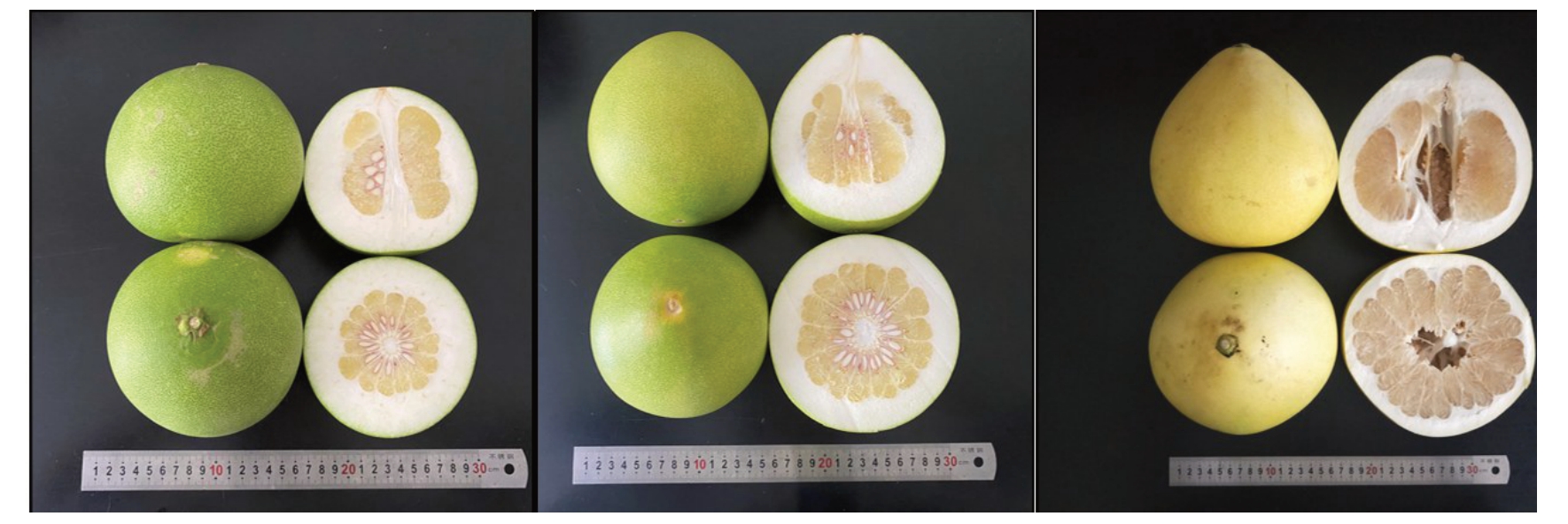
图1 不同成熟期琯溪蜜柚果实样品图
Fig.1 Samples of Guanxi pomelo fruits at different mature stages
表1 琯溪蜜柚样品采摘信息
Table 1 Sample information of Guanxi pomelo

序号Number 1 2 3品种名称Variety name琯溪蜜柚Guanxi pomelo资源编号Repository number LG0038采摘时间Picking date 2020-09-15 2020-10-15 2020-11-15
KQ5200DE 超声波清洗器,江苏昆山市超声仪器有限公司;Sigma3K15高速冷冻离心机,美国Sigma 公司;0.22 μm有机相针式滤器,上海安谱科学仪器有限公司;RE-52AA型旋转蒸发仪,上海亚荣生化仪器厂;KS260 摇床,德国IKA 公司;SHZ-D 型循环水式真空泵,巩义予华仪器有限公司;UPLC色谱仪(2996PDA检测器),美国Waters公司;7890A/5975C气相色谱一单四极杆质谱仪,美国Agilent公司。
1.2 类黄酮测定
参考冉玥等[15]的方法,称取样品5.00 g 于离心管中,加入10 mL甲醇和二甲基亚砜体积比=1∶1,超声提取30 min,10 000 r·min-1离心10 min,收集上清液,提取2次,定容至25 mL,经0.22 μm微孔有机滤膜过滤后上机检测。
UPLC 条件:流动相:0.2%乙酸水溶液(A)和甲醇(B);流速:0.30 mL·min-1,柱温:35 ℃;波长为283 nm。
1.3 酚酸含量测定
参考张静等[16]的方法,取样品5.00 g 于离心管中,加入4 mol·L-1 10 mL NaOH溶液,振荡反应4 h;调节pH 至2.0(6 mol·L-1 盐酸,约12 mL),10 000 r·min-1离心5 min;取上清液,用乙酸乙酯和甲基叔丁基醚(体积比1∶1)萃取3 次;合并萃取液,旋转蒸发浓缩至干,用50%甲醇定容至5 mL,经0.22 μm微孔有机滤膜过滤后上机检测。
UPLC 条件—色谱柱:ACQUITY UPLC BEH C18 分析柱(2.1 mm × 100 mm,1.7 μm);流动相:3.0%甲酸水溶液(A)和甲醇溶液(B);流速:0.30 mL·min-1;柱温:35 ℃;进样量为3.0µL;检测波长:原儿茶酸、对羟基苯甲酸和香草酸为260 nm,咖啡酸、p-香豆酸、芥子酸和阿魏酸为320 nm。
1.4 香豆素含量测定
与类黄酮提取方法一致。
UPLC 条件:流动相:0.1%乙酸水溶液(A)和乙酸甲醇溶液(B);流速:0.20 mL·min-1,柱温:40 ℃;进样量为3.0µL;检测波长:330 nm和300 nm。
1.5 类柠檬苦素含量测定
参考李一兵等[17]的方法,称取样品5.00 g 于离心管中,加入10 mL二氯甲烷,高速匀浆提取5 min,10 000 r·min-1离心5 min,收集上清液,再重复上述操作1次,合并2次提取的下层液,旋蒸浓缩至干,用甲醇定容至2.0 mL,经0.22 μm 微孔有机滤膜过滤后上机检测。
UPLC 条件——流速:0.3 mL·min-1;流动相比例:乙腈、水=40∶60;柱温:35 ℃;波长:210 nm;进样量:3 μL。
1.6 挥发性物质含量测定
参考郑洁等[18]的方法,将采摘的柚果表面擦拭干净,四分法切开得到果皮,打碎混匀,称取3.00 g样品,置20 mL 螺口样品瓶中,加入3.00 mL 饱和食盐水和2.00 μL环己酮(99.5%)作为内标物,用聚四氟乙烯隔垫密封,于50 ℃磁力搅拌器上加热平衡20 min。用萃取头顶空吸附50 min 后,将萃取头插入GC进样,解析5 min。每份样品各3个平行。
定性和半定量分析:利用Flavour 2.0、NST 08质谱库和相关文献[17-19]对其定性,使用内标物环己酮对挥发性成分进行半定量,含量(w)单位为μg·g-1。
1.7 数据统计分析
采用SPSS Statistics 26.0 软件进行单因素方差分析(ANOVA),用SIMCA软件进行主成分分析,用Excel 2019进行图表绘制及数据整理。
2 结果与分析
2.1 不同成熟期琯溪蜜柚类黄酮含量的比较
表2所示为测定不同成熟期琯溪蜜柚不同部位4 种主要类黄酮的含量,新圣草次苷、柚皮苷、新橙皮苷和野漆树苷含量都在果实成熟期呈下降的趋势,且受成熟阶段的影响显著(p <0.05)。从总体来看,黄皮层、囊衣、果肉、果汁在青色(未成熟)阶段总 含 量(w,后 同)高 达3 753.768、5 612.382、205.217、76.925 mg·kg-1,白皮层和种子则在青转黄(半成熟)阶段类黄酮总含量最高,分别为5 410.967、452.719 mg·kg-1。同一成熟期黄皮层、白皮层、囊衣含量均为柚皮苷>野漆树苷>新圣草次苷>新橙皮苷,新橙皮苷在黄皮层、白皮层中未检出;同一成熟期果肉、果汁、种子中含量为柚皮苷>野漆树苷>新橙皮苷>新圣草次苷。3个成熟阶段琯溪蜜柚柚皮苷含量占比最高,且随着成熟期的延长而急速下降,黄皮层、白皮层、囊衣、种子、果肉、果汁柚皮苷含量变幅占比分别为85.41%~89.28%、94.65%~97.11%、96.12%~97.18%、88.41%~90.69%、65.00%~73.73%、75.43%~79.42%。
表2 不同成熟期琯溪蜜柚类黄酮含量
Table 2 The contents of flavonoids in Guanxi pomelo fruits at different mature stages (mg·kg-1)
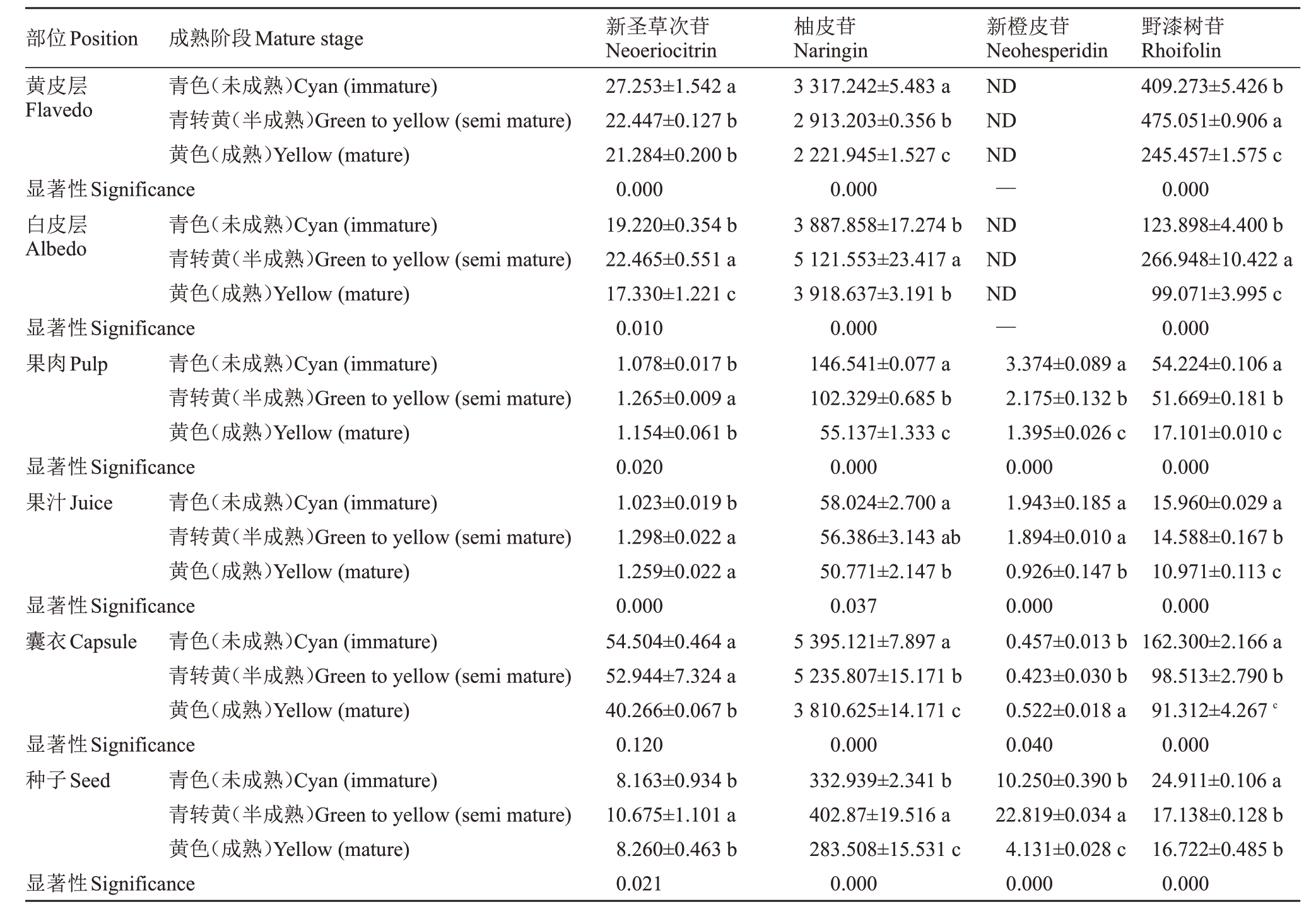
注:“ND”代表未检出;“—”代表无。不同小写字母表示在p <0.05 差异显著。下同。
Note:“ND”means no detected;“—”means none.Different small letters indicate significant difference at p <0.05.The same below.
部位Position黄皮层Flavedo野漆树苷Rhoifolin 409.273±5.426 b 475.051±0.906 a 245.457±1.575 c 0.000 123.898±4.400 b 266.948±10.422 a 99.071±3.995 c 0.000 54.224±0.106 a 51.669±0.181 b 17.101±0.010 c 0.000 15.960±0.029 a 14.588±0.167 b 10.971±0.113 c 0.000 162.300±2.166 a 98.513±2.790 b 91.312±4.267c 0.000 24.911±0.106 a 17.138±0.128 b 16.722±0.485 b 0.000成熟阶段Mature stage青色(未成熟)Cyan(immature)青转黄(半成熟)Green to yellow(semi mature)黄色(成熟)Yellow(mature)柚皮苷Naringin显著性Significance白皮层Albedo 3 317.242±5.483 a 2 913.203±0.356 b 2 221.945±1.527 c 0.000青色(未成熟)Cyan(immature)青转黄(半成熟)Green to yellow(semi mature)黄色(成熟)Yellow(mature)显著性Significance果肉Pulp 3 887.858±17.274 b 5 121.553±23.417 a 3 918.637±3.191 b 0.000青色(未成熟)Cyan(immature)青转黄(半成熟)Green to yellow(semi mature)黄色(成熟)Yellow(mature)显著性Significance果汁Juice 青色(未成熟)Cyan(immature)青转黄(半成熟)Green to yellow(semi mature)黄色(成熟)Yellow(mature)显著性Significance囊衣Capsule 146.541±0.077 a 102.329±0.685 b 55.137±1.333 c 0.000 58.024±2.700 a 56.386±3.143 ab 50.771±2.147 b 0.037青色(未成熟)Cyan(immature)青转黄(半成熟)Green to yellow(semi mature)黄色(成熟)Yellow(mature)5 395.121±7.897 a 5 235.807±15.171 b 3 810.625±14.171 c显著性Significance种子Seed 青色(未成熟)Cyan(immature)青转黄(半成熟)Green to yellow(semi mature)黄色(成熟)Yellow(mature)显著性Significance新圣草次苷Neoeriocitrin 27.253±1.542 a 22.447±0.127 b 21.284±0.200 b 0.000 19.220±0.354 b 22.465±0.551 a 17.330±1.221 c 0.010 1.078±0.017 b 1.265±0.009 a 1.154±0.061 b 0.020 1.023±0.019 b 1.298±0.022 a 1.259±0.022 a 0.000 54.504±0.464 a 52.944±7.324 a 40.266±0.067 b 0.120 8.163±0.934 b 10.675±1.101 a 8.260±0.463 b 0.021 0.000 332.939±2.341 b 402.87±19.516 a 283.508±15.531 c 0.000新橙皮苷Neohesperidin ND ND ND—ND ND ND—3.374±0.089 a 2.175±0.132 b 1.395±0.026 c 0.000 1.943±0.185 a 1.894±0.010 a 0.926±0.147 b 0.000 0.457±0.013 b 0.423±0.030 b 0.522±0.018 a 0.040 10.250±0.390 b 22.819±0.034 a 4.131±0.028 c 0.000
2.2 不同成熟期琯溪蜜柚酚酸含量的比较
表3所示为测定琯溪蜜柚7种酚酸的含量,不同成熟期琯溪蜜柚不同部位均有检出,并且7 种酚酸均存在极显著差异(p <0.001)。根据在同一成熟阶段不同部位酚酸总含量来看,呈现以下规律:黄皮层>种子>囊衣>白皮层>果肉>果汁,且肉桂酸类酚酸含量显著高于苯甲酸类酚酸。根据在同一部位不同成熟期酚酸总含量来看,黄皮层、白皮层、囊衣、种子、果汁成熟期酚酸总含量都高于未成熟期,果肉酚酸总量随成熟期延长而下降。单一酚酸含量随成熟阶段变化趋势:原儿茶酸含量随着成熟期的延长,在成熟阶段比未成熟阶段都有所增长(除种子),在果汁半成熟阶段中最丰富,达3.509 mg·kg-1;对羟基苯甲酸含量变化呈现先上升后下降的趋势,对羟基苯甲酸黄皮层半成熟阶段中最丰富,达9.592 mg·kg-1;香草酸含量成熟阶段相较其他2个成熟阶段有所下降,在半成熟阶段种子最丰富,达11.057 mg·kg-1;咖啡酸含量在黄皮层和果汁呈先上升后下降的趋势,果肉和种子呈下降的趋势,白皮层呈上升的趋势,果汁中呈先下降后上升的趋势,咖啡酸在果肉中最丰富,达7.520 mg·kg-1(未成熟);p-香豆酸含量在果肉和果汁呈下降的趋势,含量变化范围分别为2.953~7.433、2.207~3.478 mg·kg-1,白皮层和种子呈上升的趋势,黄皮层呈先下降后上升的趋势,囊衣呈先上升后下降的趋势;阿魏酸含量在黄皮层和囊衣呈上升的趋势,果肉和果汁呈下降的趋势,白皮层呈先上升后下降的趋势,种子呈先下降后上升的趋势,阿魏酸在黄皮层中最丰富,达24.555 mg·kg-1(成熟);芥子酸在黄皮层、白皮层、果肉、囊衣呈先上升后下降的趋势,果汁中呈上升的趋势,种子中呈下降的趋势。
表3 不同成熟期琯溪蜜柚酚酸含量
Table 3 The contents of phenolic acids in Guanxi pomelo fruits at different mature stages (mg·kg-1)
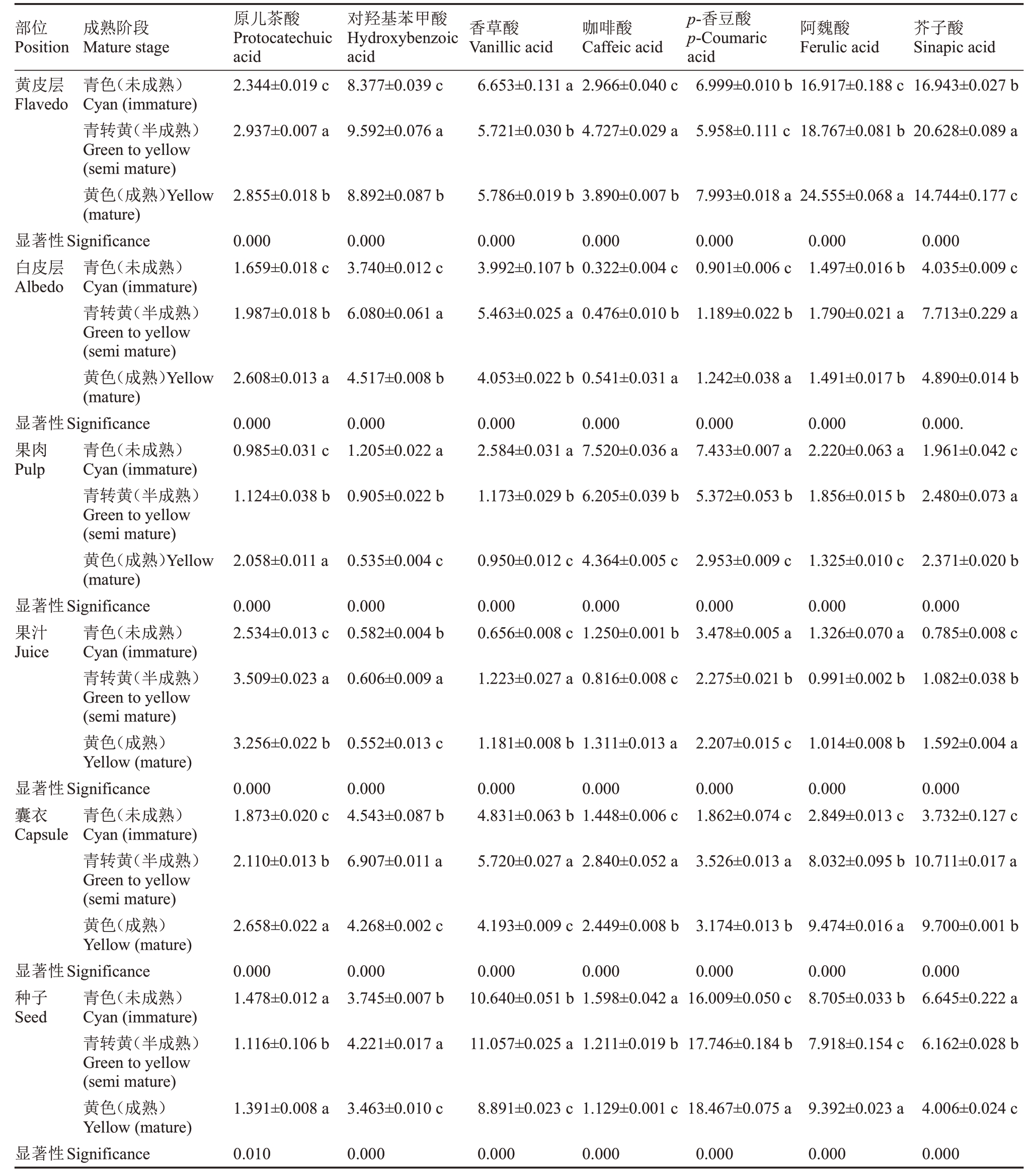
部位Position成熟阶段Mature stage香草酸Vanillic acid咖啡酸Caffeic acid阿魏酸Ferulic acid芥子酸Sinapic acid黄皮层Flavedo青色(未成熟)Cyan(immature)青转黄(半成熟)Green to yellow(semi mature)黄色(成熟)Yellow(mature)原儿茶酸Protocatechuic acid 2.344±0.019 c对羟基苯甲酸Hydroxybenzoic acid 8.377±0.039 c 6.653±0.131 a 2.966±0.040 c p-香豆酸p-Coumaric acid 6.999±0.010 b 16.917±0.188 c 16.943±0.027 b 2.937±0.007 a 9.592±0.076 a 5.721±0.030 b 4.727±0.029 a 5.958±0.111 c 18.767±0.081 b 20.628±0.089 a 2.855±0.018 b 8.892±0.087 b 5.786±0.019 b 3.890±0.007 b 7.993±0.018 a 24.555±0.068 a 14.744±0.177 c显著性Significance白皮层Albedo青色(未成熟)Cyan(immature)青转黄(半成熟)Green to yellow(semi mature)黄色(成熟)Yellow(mature)显著性Significance果肉Pulp青色(未成熟)Cyan(immature)青转黄(半成熟)Green to yellow(semi mature)黄色(成熟)Yellow(mature)显著性Significance果汁Juice青色(未成熟)Cyan(immature)青转黄(半成熟)Green to yellow(semi mature)黄色(成熟)Yellow(mature)0.000 1.659±0.018 c 1.987±0.018 b 2.608±0.013 a 0.000 0.985±0.031 c 1.124±0.038 b 2.058±0.011 a 0.000 2.534±0.013 c 3.509±0.023 a 3.256±0.022 b 0.000 3.740±0.012 c 6.080±0.061 a 4.517±0.008 b 0.000 1.205±0.022 a 0.905±0.022 b 0.535±0.004 c 0.000 0.582±0.004 b 0.606±0.009 a 0.552±0.013 c 0.000 3.992±0.107 b 0.000 0.322±0.004 c 5.463±0.025 a 0.476±0.010 b 4.053±0.022 b 0.541±0.031 a 0.000 2.584±0.031 a 0.000 7.520±0.036 a 1.173±0.029 b 6.205±0.039 b 0.950±0.012 c 4.364±0.005 c 0.000 0.656±0.008 c 0.000 1.250±0.001 b 1.223±0.027 a 0.816±0.008 c 1.181±0.008 b 1.311±0.013 a 0.000 0.901±0.006 c 1.189±0.022 b 1.242±0.038 a 0.000 7.433±0.007 a 5.372±0.053 b 2.953±0.009 c 0.000 3.478±0.005 a 2.275±0.021 b 2.207±0.015 c 0.000 1.497±0.016 b 1.790±0.021 a 1.491±0.017 b 0.000 2.220±0.063 a 1.856±0.015 b 1.325±0.010 c 0.000 1.326±0.070 a 0.991±0.002 b 1.014±0.008 b 0.000 4.035±0.009 c 7.713±0.229 a 4.890±0.014 b 0.000.1.961±0.042 c 2.480±0.073 a 2.371±0.020 b 0.000 0.785±0.008 c 1.082±0.038 b 1.592±0.004 a显著性Significance囊衣Capsule青色(未成熟)Cyan(immature)青转黄(半成熟)Green to yellow(semi mature)黄色(成熟)Yellow(mature)0.000 1.873±0.020 c 2.110±0.013 b 2.658±0.022 a 0.000 4.543±0.087 b 6.907±0.011 a 4.268±0.002 c 0.000 4.831±0.063 b 0.000 1.448±0.006 c 5.720±0.027 a 2.840±0.052 a 4.193±0.009 c 2.449±0.008 b 0.000 1.862±0.074 c 3.526±0.013 a 3.174±0.013 b 0.000 2.849±0.013 c 0.000 3.732±0.127 c 8.032±0.095 b 10.711±0.017 a 9.474±0.016 a 9.700±0.001 b显著性Significance种子Seed青色(未成熟)Cyan(immature)青转黄(半成熟)Green to yellow(semi mature)黄色(成熟)Yellow(mature)0.000 1.478±0.012 a 1.116±0.106 b 1.391±0.008 a 0.000 3.745±0.007 b 4.221±0.017 a 3.463±0.010 c 0.000 10.640±0.051 b 0.000 1.598±0.042 a 0.000 16.009±0.050 c 11.057±0.025 a 1.211±0.019 b 17.746±0.184 b 8.891±0.023 c 1.129±0.001 c 18.467±0.075 a 0.000 8.705±0.033 b 7.918±0.154 c 9.392±0.023 a 0.000 6.645±0.222 a 6.162±0.028 b 4.006±0.024 c显著性Significance 0.010 0.000 0.000 0.000 0.000 0.000 0.000
2.3 不同成熟期琯溪蜜柚香豆素含量的比较
由表4可知,不同成熟阶段琯溪蜜柚成熟期间5种主要香豆素组分的含量存在极显著差异(p <0.001)。从同一成熟阶段不同部位香豆素总含量来看,未成熟期香豆素总量呈黄皮层>果肉>果汁>囊衣>白皮层>种子的规律;半成熟阶段和成熟阶段香豆素总含量呈相同的规律:黄皮层>果肉>囊衣>果汁>白皮层>种子。从同一部位不同成熟期香豆素总含量来看,黄皮层中香豆素总含量随着成熟阶段的延长而上升,白皮层、果汁、种子香豆素含量随着成熟阶段的延长而下降,果肉、囊衣香豆素总含量先上升后下降,其中黄皮层、白皮层、果肉、果汁、囊衣、种子含量变化范围分别为:133.189~397.775、1.528~2.662、7.589~15.673、2.276~8.253、3.110~4.574、0.745~1.679 mg·kg-1。单一香豆素在不同成熟期不同部位含量变化不尽相同,伞形花内酯在6 个部位含量变化差异不大;橙皮内酯水合物在果肉、果汁、囊衣随着成熟期延长呈下降的趋势,黄皮层呈上升的趋势,含量变化范围为63.271~200.030 mg·kg-1,种子中未检出;6,7-二羟基香柠檬亭在白皮层、果肉、囊衣、种子随着成熟阶段的延长呈现先上升后下降的趋势,黄皮层呈上升的趋势,果汁呈下降的趋势;橙皮油素在黄皮层和果肉随着成熟期延长呈先上升后下降的趋势,囊衣、种子、白皮层和果汁呈下降的趋势;香柠檬亭在黄皮层、白皮层、果肉、囊衣呈先上升后下降的趋势,果汁和种子呈下降的趋势。
表4 不同成熟期琯溪蜜柚香豆素含量
Table 4 The contents of coumarins in Guanxi pomelo fruits at different mature stages (mg·kg-1)
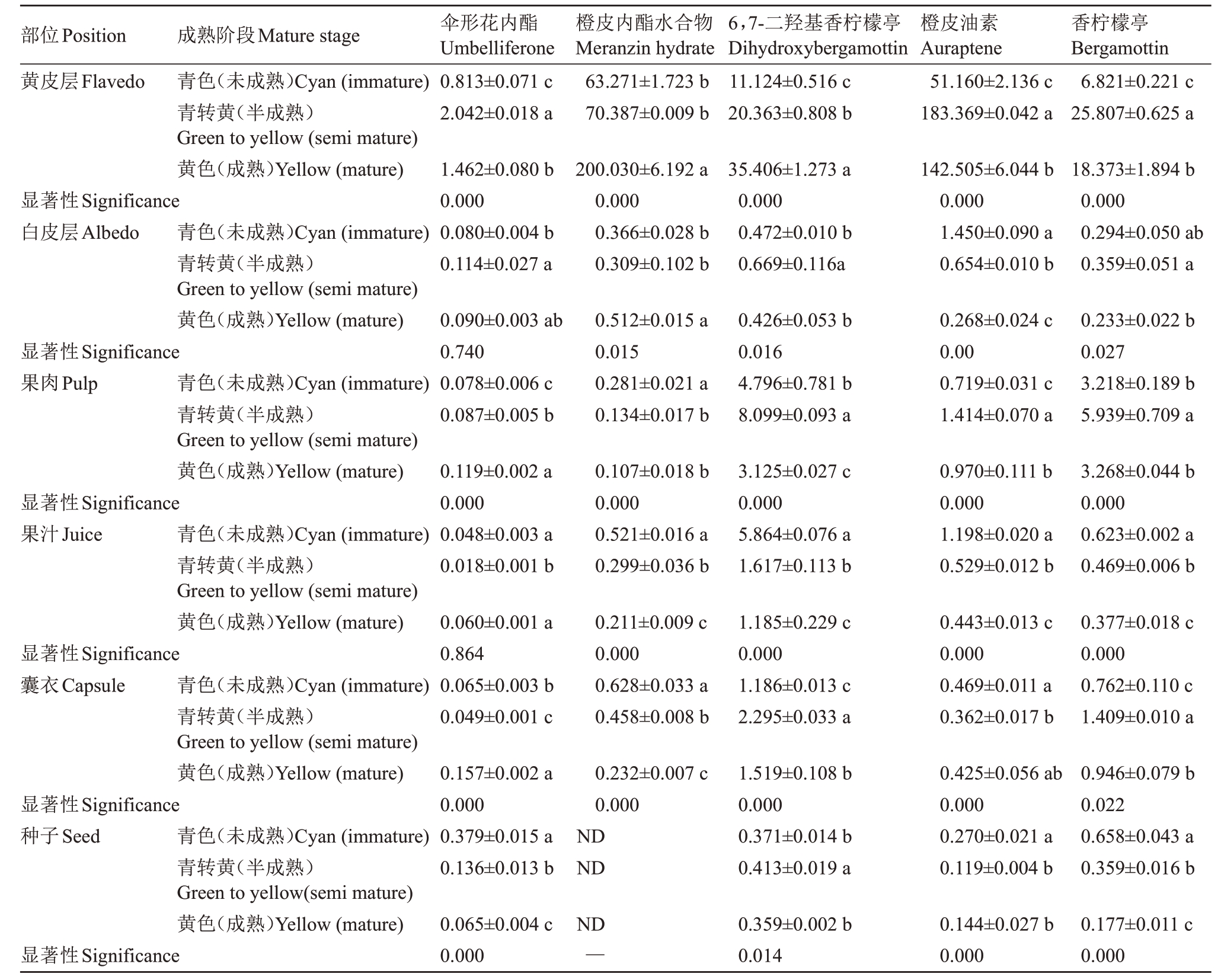
部位Position黄皮层Flavedo成熟阶段Mature stage青色(未成熟)Cyan(immature)青转黄(半成熟)Green to yellow(semi mature)黄色(成熟)Yellow(mature)伞形花内酯Umbelliferone 0.813±0.071 c 2.042±0.018 a橙皮内酯水合物Meranzin hydrate 63.271±1.723 b 70.387±0.009 b 6,7-二羟基香柠檬亭Dihydroxybergamottin 11.124±0.516 c 20.363±0.808 b橙皮油素Auraptene 51.160±2.136 c 183.369±0.042 a香柠檬亭Bergamottin 6.821±0.221 c 25.807±0.625 a显著性Significance白皮层Albedo 青色(未成熟)Cyan(immature)青转黄(半成熟)Green to yellow(semi mature)黄色(成熟)Yellow(mature)1.462±0.080 b 0.000 0.080±0.004 b 0.114±0.027 a 200.030±6.192 a 0.000 0.366±0.028 b 0.309±0.102 b 35.406±1.273 a 0.000 0.472±0.010 b 0.669±0.116a 142.505±6.044 b 0.000 1.450±0.090 a 0.654±0.010 b 18.373±1.894 b 0.000 0.294±0.050 ab 0.359±0.051 a显著性Significance果肉Pulp 青色(未成熟)Cyan(immature)青转黄(半成熟)Green to yellow(semi mature)黄色(成熟)Yellow(mature)0.090±0.003 ab 0.740 0.078±0.006 c 0.087±0.005 b 0.512±0.015 a 0.015 0.281±0.021 a 0.134±0.017 b 0.426±0.053 b 0.016 4.796±0.781 b 8.099±0.093 a 0.268±0.024 c 0.00 0.719±0.031 c 1.414±0.070 a 0.233±0.022 b 0.027 3.218±0.189 b 5.939±0.709 a显著性Significance果汁Juice 青色(未成熟)Cyan(immature)青转黄(半成熟)Green to yellow(semi mature)黄色(成熟)Yellow(mature)0.119±0.002 a 0.000 0.048±0.003 a 0.018±0.001 b 0.107±0.018 b 0.000 0.521±0.016 a 0.299±0.036 b 3.125±0.027 c 0.000 5.864±0.076 a 1.617±0.113 b 0.970±0.111 b 0.000 1.198±0.020 a 0.529±0.012 b 3.268±0.044 b 0.000 0.623±0.002 a 0.469±0.006 b显著性Significance囊衣Capsule 青色(未成熟)Cyan(immature)青转黄(半成熟)Green to yellow(semi mature)黄色(成熟)Yellow(mature)0.060±0.001 a 0.864 0.065±0.003 b 0.049±0.001 c 0.211±0.009 c 0.000 0.628±0.033 a 0.458±0.008 b 1.185±0.229 c 0.000 1.186±0.013 c 2.295±0.033 a 0.443±0.013 c 0.000 0.469±0.011 a 0.362±0.017 b 0.377±0.018 c 0.000 0.762±0.110 c 1.409±0.010 a显著性Significance种子Seed 青色(未成熟)Cyan(immature)青转黄(半成熟)Green to yellow(semi mature)黄色(成熟)Yellow(mature)0.157±0.002 a 0.000 0.379±0.015 a 0.136±0.013 b 0.232±0.007 c 0.000 ND ND 1.519±0.108 b 0.000 0.371±0.014 b 0.413±0.019 a 0.425±0.056 ab 0.000 0.270±0.021 a 0.119±0.004 b 0.946±0.079 b 0.022 0.658±0.043 a 0.359±0.016 b显著性Significance 0.065±0.004 c 0.000 ND—0.359±0.002 b 0.014 0.144±0.027 b 0.000 0.177±0.011 c 0.000
2.4 不同成熟期琯溪蜜柚类柠檬苦素含量的比较
表5所示为不同成熟期琯溪蜜柚不同部位类柠檬苦素的含量,显著差异分析显示琯溪蜜柚在成熟过程中的柠檬苦素、诺米林和黄柏酮含量的差异非常显著(p <0.001)。由表5 可知,种子中类柠檬苦素含量最丰富,黄柏酮只在种子检出,其中种子中柠檬苦素、诺米林和黄柏酮随着成熟期的延长,含量不断上升,分别增长了47.11%、60.90%、86.47%。黄皮层、白皮层、囊衣、果肉、果汁中柠檬苦素和诺米林在成熟期间急剧下降,柠檬苦素分别下降了25.99%、94.47%、41.65%、30.41%、66.79%,诺米林分别下降了45.42%、74.57%、54.17%、43.51%、21.41%。
表5 不同成熟期琯溪蜜柚类柠檬苦素含量
Table 5 The contents of limonoids in Guanxi pomelo fruits at different mature stages (mg·kg-1)
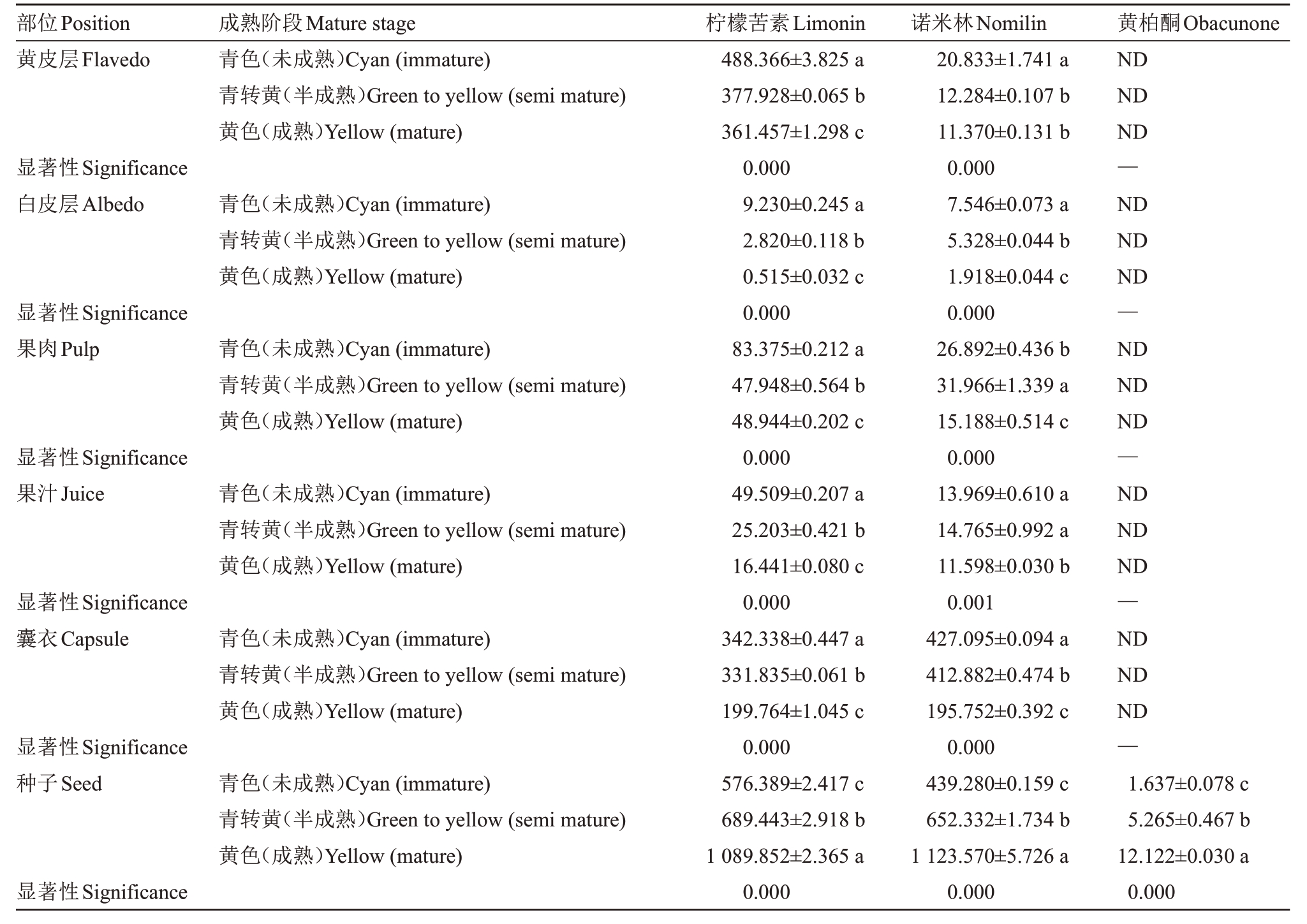
部位Position黄皮层Flavedo成熟阶段Mature stage青色(未成熟)Cyan(immature)青转黄(半成熟)Green to yellow(semi mature)黄色(成熟)Yellow(mature)显著性Significance白皮层Albedo 青色(未成熟)Cyan(immature)青转黄(半成熟)Green to yellow(semi mature)黄色(成熟)Yellow(mature)显著性Significance果肉Pulp 青色(未成熟)Cyan(immature)青转黄(半成熟)Green to yellow(semi mature)黄色(成熟)Yellow(mature)显著性Significance果汁Juice 青色(未成熟)Cyan(immature)青转黄(半成熟)Green to yellow(semi mature)黄色(成熟)Yellow(mature)显著性Significance囊衣Capsule 青色(未成熟)Cyan(immature)青转黄(半成熟)Green to yellow(semi mature)黄色(成熟)Yellow(mature)显著性Significance种子Seed 青色(未成熟)Cyan(immature)青转黄(半成熟)Green to yellow(semi mature)黄色(成熟)Yellow(mature)柠檬苦素Limonin 488.366±3.825 a 377.928±0.065 b 361.457±1.298 c 0.000 9.230±0.245 a 2.820±0.118 b 0.515±0.032 c 0.000 83.375±0.212 a 47.948±0.564 b 48.944±0.202 c 0.000 49.509±0.207 a 25.203±0.421 b 16.441±0.080 c 0.000 342.338±0.447 a 331.835±0.061 b 199.764±1.045 c 0.000 576.389±2.417 c 689.443±2.918 b诺米林Nomilin 20.833±1.741 a 12.284±0.107 b 11.370±0.131 b 0.000 7.546±0.073 a 5.328±0.044 b 1.918±0.044 c 0.000 26.892±0.436 b 31.966±1.339 a 15.188±0.514 c 0.000 13.969±0.610 a 14.765±0.992 a 11.598±0.030 b 0.001 427.095±0.094 a 412.882±0.474 b 195.752±0.392 c 0.000 439.280±0.159 c 652.332±1.734 b 1 089.852±2.365 a 1 123.570±5.726 a显著性Significance 0.000 0.000黄柏酮Obacunone ND ND ND—ND ND ND—ND ND ND—ND ND ND—ND ND ND—1.637±0.078 c 5.265±0.467 b 12.122±0.030 a 0.000
2.5 不同成熟期琯溪蜜柚果皮香气物质含量的比较
由表6 可知,利用GC-MS 在3 个成熟阶段琯溪蜜柚黄皮层共检测到51 种香气物质,其中在青色(未成熟)阶段、青转黄(半成熟)阶段、黄色(成熟)阶段中分别检测到34、25、42 种;随着成熟期的延长,琯溪蜜柚黄皮层中共测得香气物质总含量呈增长的趋势,分别为7 896.769、8 664.805 和10 380.399 μg·g-1。在3个成熟阶段琯溪蜜柚果皮所的香气物质中,单萜类物质和倍半萜类物质含量较高,其次为醇类和醛类物质。黄色(成熟)阶段的单萜类、倍单萜类、醛类、醇类、酯类、酮类物质含量均高于其他2 个成熟期,其中柠檬烯占比高达总含量的78.48%。
表6 不同成熟期琯溪蜜柚果皮挥发物成分含量
Table 6 The contents of volatile compounds in Guanxi pomelo flavedo at different mature stages (μg·g-1)

注:“ND”代表未检出。Note:“ND”means no detected.
成熟阶段Mature stage挥发性成分物质分类Classification of volatile compounds单萜类Monoterpenes醛合计Sum青色(未成熟)Cyan(immature)青转黄(半成熟)Green to yellow(semi mature)黄色(成熟)Yellow(mature)7 131.510(7)7 829.534(5)倍单萜类Sesquiterpenes 297.979(8)454.985(9)类Aldehydes 47.717(3)102.937(3)醇类Alcohols 375.213(10)270.889(5)酯类Esters 17.546(4)1.606(1)酮类Ketones 12.916(2)1.995(1)其他Others ND 2.859(1)7 896.769(34)8 664.805(25)9 171.815(9)502.440(11)189.838(9)464.719(8)27.746(3)20.632(1)3.209(1)10 380.399(42)
根据香气活度植理论,食品中香气浓度高而阈植低的成分很可能是食品的特征香气,物质浓度高不一定对样品的香气有很大的贡献(如柠檬烯),而含量低的物质也有可能对整体香气有大的影响。OAV 的水平可以反映挥发性风味成分对样品特征香气的贡献,以往的研究表明OAV 越高,化合物的个体贡献和影响越大。查阅相关文献得到香气物质的香气阈植[19-21],结合GC-MS 的定量结果,计算所得OAV植。表7所示为3个成熟阶段琯溪蜜柚黄皮层中OAV >1的香气物质总共35种,随着成熟期延长,OAV植也呈上升的趋势,其中醇类、醛类、酮类、酯类、单萜类和倍半萜类分别有9、9、2、4、7和4种。黄色(成熟)阶段包含最多的特征香气物质,为30种,其次为未成熟,包含24种,半成熟最少,为15种。
表7 不同成熟期琯溪蜜柚果皮香气物质的OAV
Table 7 OAV of volatile compounds in Guanxi pomelo flavedo at different mature stages
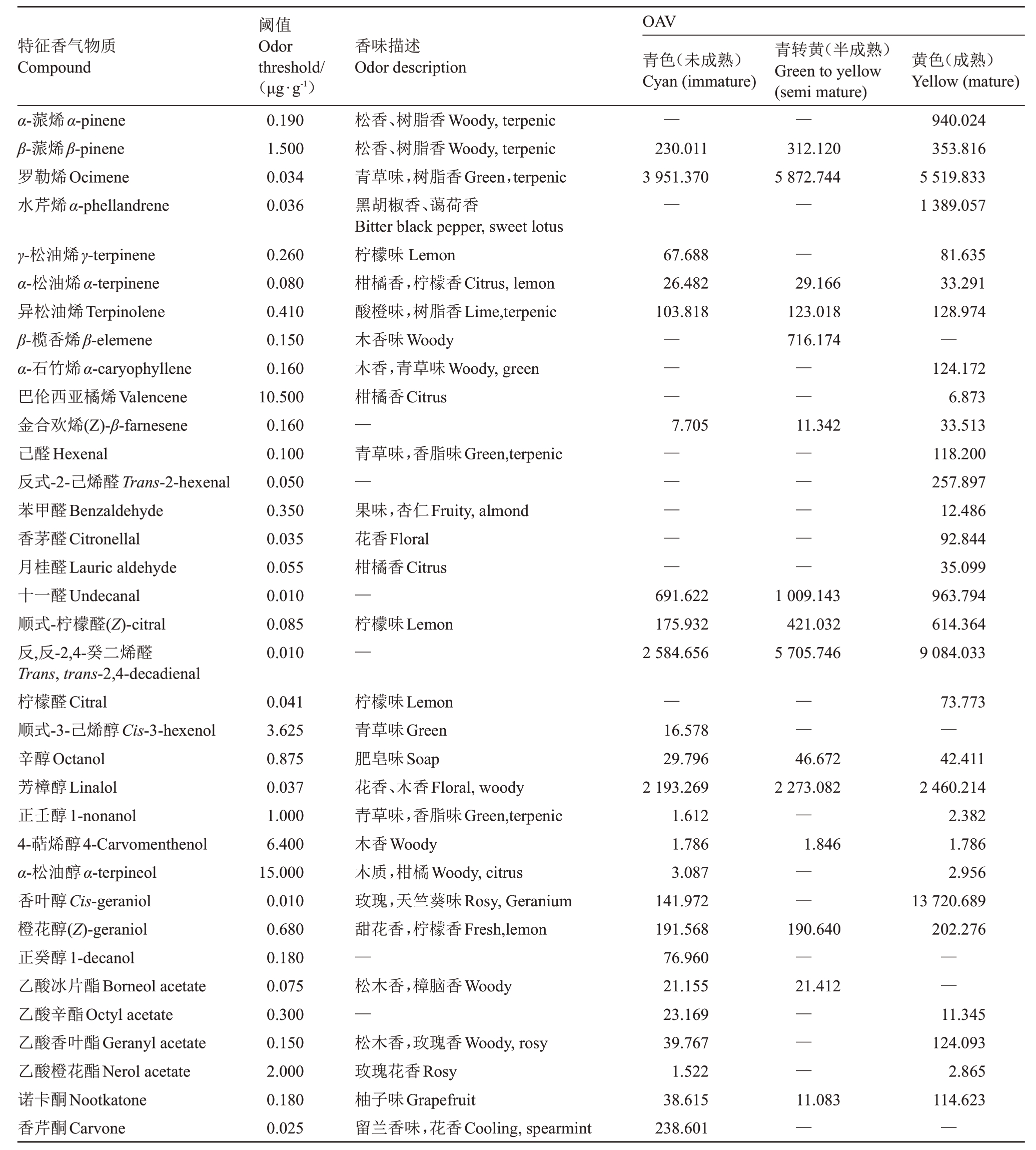
特征香气物质Compound香味描述Odor description α-蒎烯α-pinene β-蒎烯β-pinene罗勒烯Ocimene水芹烯α-phellandrene阈植Odor threshold/(μg·g-1)0.190 1.500 0.034 0.036 OAV青色(未成熟)Cyan(immature)—230.011青转黄(半成熟)Green to yellow(semi mature)—312.120松香、树脂香Woody,terpenic松香、树脂香Woody,terpenic青草味,树脂香Green,terpenic黑胡椒香、蔼荷香Bitter black pepper,sweet lotus柠檬味Lemon柑橘香,柠檬香Citrus,lemon酸橙味,树脂香Lime,terpenic木香味Woody木香,青草味Woody,green柑橘香Citrus—青草味,香脂味Green,terpenic—果味,杏仁Fruity,almond花香Floral柑橘香Citrus—柠檬味Lemon—黄色(成熟)Yellow(mature)940.024 353.816 3 951.370 5 872.744—5 519.833 1 389.057 γ-松油烯γ-terpinene α-松油烯α-terpinene异松油烯Terpinolene β-榄香烯β-elemene α-石竹烯α-caryophyllene巴伦西亚橘烯Valencene金合欢烯(Z)-β-farnesene己醛Hexenal反式-2-己烯醛Trans-2-hexenal苯甲醛Benzaldehyde香茅醛Citronellal月桂醛Lauric aldehyde十一醛Undecanal顺式-柠檬醛(Z)-citral反,反-2,4-癸二烯醛Trans,trans-2,4-decadienal柠檬醛Citral顺式-3-己烯醇Cis-3-hexenol辛醇Octanol芳樟醇Linalol正壬醇1-nonanol 4-萜烯醇4-Carvomenthenol α-松油醇α-terpineol香叶醇Cis-geraniol橙花醇(Z)-geraniol正癸醇1-decanol乙酸冰片酯Borneol acetate乙酸辛酯Octyl acetate乙酸香叶酯Geranyl acetate乙酸橙花酯Nerol acetate诺卡酮Nootkatone香芹酮Carvone 0.260 0.080 0.410 0.150 0.160 10.500 0.160 0.100 0.050 0.350 0.035 0.055 0.010 0.085 0.010 67.688 26.482 103.818——— —29.166 123.018 716.174——7.705 11.342————691.622 175.932 81.635 33.291 128.974—124.172 6.873 33.513 118.200 257.897 12.486 92.844 35.099 963.794 614.364 2 584.656 1 009.143 421.032 5 705.746 9 084.033 0.041 3.625 0.875 0.037 1.000 6.400 15.000 0.010 0.680 0.180 0.075 0.300 0.150 2.000 0.180 0.025柠檬味Lemon青草味Green肥皂味Soap花香、木香Floral,woody青草味,香脂味Green,terpenic木香Woody木质,柑橘Woody,citrus玫瑰,天竺葵味Rosy,Geranium甜花香,柠檬香Fresh,lemon—松木香,樟脑香Woody—松木香,玫瑰香Woody,rosy玫瑰花香Rosy柚子味Grapefruit留兰香味,花香Cooling,spearmint—16.578 29.796——46.672 73.773—42.411 2 193.269 1.612 1.786 3.087 141.972 191.568 76.960 21.155 23.169 39.767 1.522 38.615 238.601 2 273.082 2 460.214—1.846——2.382 1.786 2.956 13 720.689 190.640—21.412 202.276——— —11.083—11.345 124.093 2.865 114.623—
2.6 主成分分析
主 成 分 分 析(principal component analysis,PCA)是一种利用降维技术将多个变量转化为主成分的统计方法,是最重要的降维方法之一[22]。水平和垂直坐标为主成分,每个向量代表原始特征,向量在主成分上的投影可以表示两者之间的相关程度[23]。笔者在本研究中对3个成熟阶段的琯溪蜜柚果汁样品的选取功能成分共18个进行主成分分析,F1主成分的贡献率为70.3%,F2主成分的贡献率为29.7%,2 个主成分的累计贡献率已经达到100%。青色(未成熟)、青转黄(半成熟)、黄色(成熟)分别位于第2象限、第4象限、第1象限,表明3个成熟阶段琯溪蜜柚果汁样品可以很好地区分,其不同成熟期的功能成分具有显著差异。
通过双标图(bi-plot)同时显示得分图与载荷图之间的关系,结合分析不同成熟期琯溪蜜柚综合品质。如图2,其中芥子酸、伞形花内酯位于第1象限,说明对主成分1和主成分2有较大的影响。阿魏酸、6,7-二羟基香柠檬亭、柠檬苦素、橙皮内酯水合物等物质位于第2象限,说明与主成分2呈正相关。柚皮苷、新橙皮苷、野漆树苷、诺米林、对羟基苯甲酸等物质位于第3象限,说明对主成分1和主成分2呈负相关。原儿茶酸、香草酸、新圣草次苷等物质位于第4象限,说明与主成分1有较大的相关性。主成分1和主成分2 对3 个成熟阶段琯溪蜜柚区分明显,青色(未成熟)位于第2 象限,与柠檬苦素、阿魏酸、6,7-二羟基香柠檬亭等物质有较大的相关性,青转黄(半成熟)阶段与新圣草次苷、香草酸、原儿茶酸相关性显著,黄色(成熟)阶段与芥子酸、伞形花内酯相关性显著。综上所述,不同成熟期对功能成分的影响大小高低不一致,不同成熟期琯溪蜜柚功能成分具有显著差异。
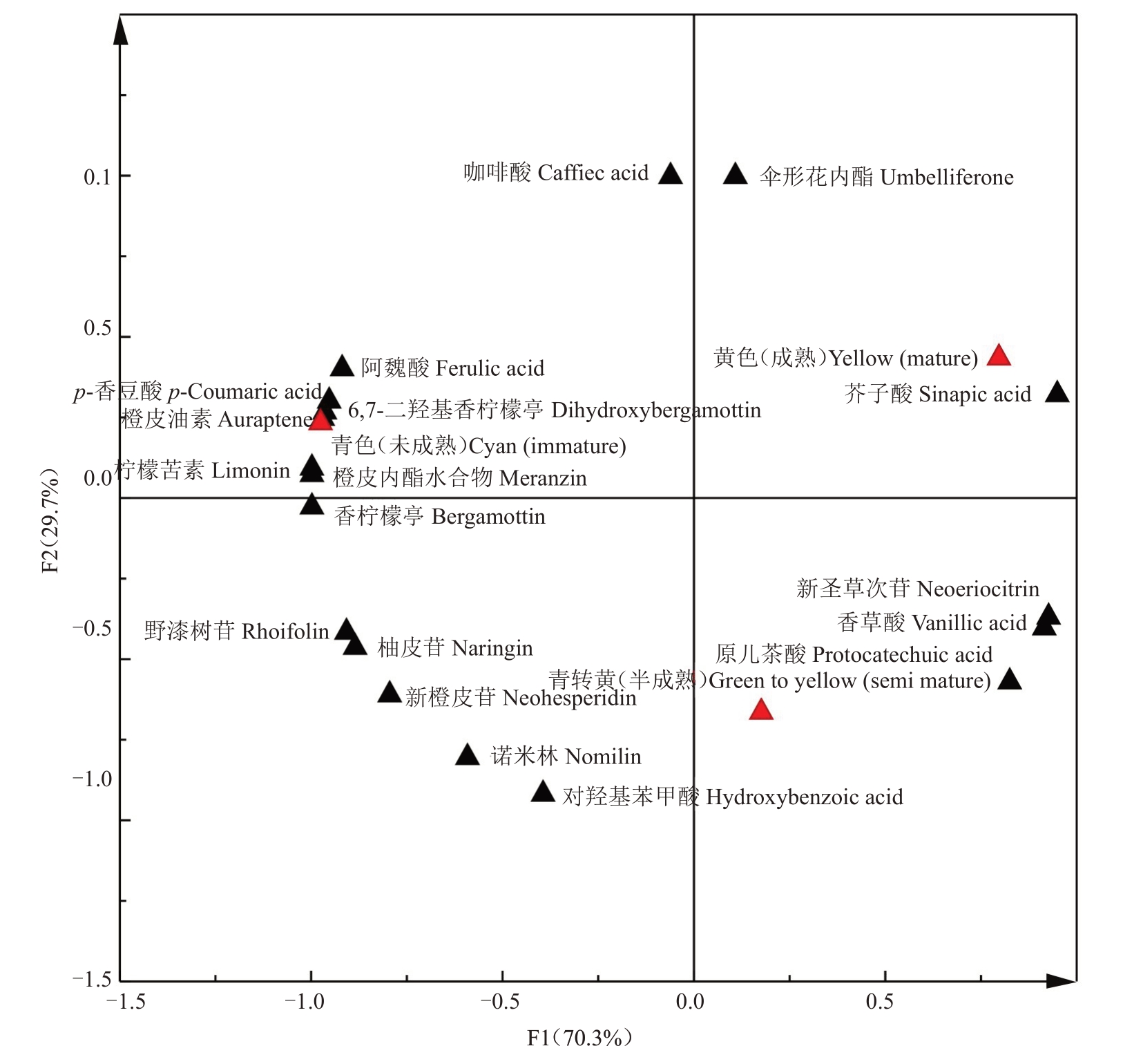
图2 基于不同成熟期琯溪蜜柚果汁功能成分的主成分分析
Fig.2 Principal component analysis based on functional components in Guanxi pomelo juice at different mature stages
3 讨 论
笔者在本研究中对不同成熟阶段的琯溪蜜柚不同部位的功能成分综合评价,结果显示:不同成熟期琯溪蜜柚4种主要类黄酮的含量都在成熟期呈下降的趋势,柚皮苷和野漆树苷是琯溪蜜柚果实占主导地位的两种黄酮类化合物。胡阳等[24]对不同生长期琯溪蜜柚中柚皮苷含量进行测定,结果表明随着成熟期的延长,果实柚皮苷含量也呈下降趋势;吴雪霞等[25]的研究表明茄子生长发育过程中类黄酮和总酚含量均呈现下降的趋势,这与琯溪蜜柚果实中的规律相似。不同成熟期琯溪蜜柚的不同部位7种酚酸的含量存在显著差异,酚酸随成熟期变化趋势不尽相同,根据在同一成熟阶段不同部位酚酸总含量来看,呈现以下规律:黄皮层>种子>囊衣>白皮层>果肉>果汁,且肉桂酸类酚酸含量显著高于苯甲酸类酚酸,这与汤春甫[26]的研究结果类似;根据在同一部位不同成熟期酚酸总含量来看,黄皮层、白皮层、囊衣、种子、果汁成熟期酚酸总含量高于未成熟期,果肉酚酸总含量随成熟期延长而下降,符合徐贵华等[27]采用HPLC-PDA 测定了不同成熟期南丰蜜橘中酚酸的含量,结果显示,果肉中酚酸含量随成熟度提高而减少。在不同成熟阶段不同部位香豆素总含量来看,黄皮层中香豆素含量最丰富,可作为提取香豆素的良好来源。类柠檬苦素随着成熟期延长而下降,其中黄皮层和囊衣下降最明显,其次是果肉、果汁、白皮层;种子中类柠檬呈现相反的趋势,且种子中类柠檬苦素最丰富,文献表明[28-29],种子中的诺米林和柠檬苦素在10月和11月显示出最高浓度,果实完全成熟后,种子中柠檬苦素浓度在12月达到最大植,并且在种子中远高于果皮,与本文研究结果相同。3个成熟阶段琯溪蜜柚黄皮层共检测到51种香气物质,随着成熟期的延长挥发性成分总含量呈增长的趋势。对3个成熟阶段的琯溪蜜柚果汁样品的18个功能成分进行主成分分析,结果表明不同成熟阶段琯溪蜜柚功能成分存在显著差异。
4 结 论
对不同成熟期琯溪蜜柚果实不同部位功能成分(类黄酮、酚酸、香豆素、类柠檬苦素和挥发性成分)的组成进行比较分析,结果表明,成熟度对琯溪蜜柚不同部位功能成分有显著性影响。同一部位,大多数类黄酮、酚酸、香豆素和类柠檬苦素含量随着成熟期延长呈现下降的趋势,少部分随着成熟期延长呈现上升的趋势;同一成熟期,黄皮层中类黄酮、酚酸和香豆素含量较高,种子中类柠檬苦素含量最丰富,分别可作为相应功能成分的天然来源;挥发性成分总含量随着成熟期的延长呈增长的趋势。基于本研究结果,笔者可选择合适的采摘期,进而充分利用某一成熟期某一部位的有效成分,比如未成熟时囊衣部位的柚皮苷、成熟时黄皮层部位的橙皮内酯水合物和成熟时种子部位的类柠檬苦素都是相对丰富的。这为不同成熟阶段的琯溪蜜柚采后资源综合利用及工业化提供方向,同时也为开发医药以及保健品提供理论指导。
[1] 丁晓波,张华,刘世尧.柑橘果品营养学研究现状[J].园艺学报,2012,39(9):1687-1702.DING Xiaobo,ZHANG Hua,LIU Shiyao. Current status of the study in citrus nutriology[J].Acta Horticulturae Sinica,2012,39(9):1687-1702.
[2] 杨亚妮,苏智先.中国名柚资源与品种现状研究[J].四川师范学院学报(自然科学版),2002,23(2):163-169.YANG Yani,SU Zhixian. Resources and actualities of breeds of famous citrus grandis in China[J]. Journal of Sichuan Teachers College(Natural Science),2002,23(2):163-169.
[3] 沈兆敏. 我国柑橘生产销售现状及发展趋势[J]. 果农之友,2021(3):1-4.SHEN Zhaomin. Status Quo and development trend of world's citrus production and sales[J]. Fruit Growers Friend,2021(3):1-4.
[4] 黄睿,沈淑妤,陈虹霖.柑橘类黄酮的生物学活性及提高生物利用度技术研究进展[J].食品科学,2019,40(1):319-326.HUANG Rui,SHEN Shuyu,CHEN Honglin. Recent advances in bioactivities and technologies for bioavailability improvement of citrus flavonoids[J]. Food Science,2019,40(1):319-326.
[5] 何雅静,张群琳,孙志高.柑橘中酚酸类化合物及其生物活性与机理的研究进展[J]. 食品与发酵工业,2020,46(15):301-306.HE Yajing,ZHANG Qunlin,SUN Zhigao. Research progress on phenolic acids in citrus and their biological activities and mechanisms[J]. Food and Fermentation Industries,2020,46(15):301-306.
[6] MILLER E G,PORTER J L,BINNIE W H,GUO I Y,SHIN H.Further studies on the anticancer activity of citrus limonoids[J].Journal of Agricultural and Food Chemistry,2004,52(15):4908-4912.
[7] 苌美燕,冯杉,李涛.柑橘属药用植物香豆素类化学成分研究进展[J].化工管理,2018(11):9-10.CHANG Meiyan,FENG Shan,LI Tao.Research progress on the chemical constituents of coumarins from citrus medicinal plants[J].Chemical Management,2018(11):9-10.
[8] 韦献果,曾明,邓烈.柑橘及其近缘属植物中天然香豆素化合物及药效作用综述[J].食品科学,2012,33(13):343-347.WEI Xianguo,ZENG Ming,DENG Lie. Natural coumarins and their pharmacodynamics from citrus and its relatives:a review[J].Food Science,2012,33(13):343-347.
[9] LIU Y Q,HE Y E,TANUMIHARDJO S A. History,global distribution,and nutritional importance of citrus fruits[J]. Comprehensive Reviews in Food Science and Food Safety,2012,11(6):530-545.
[10] MAHMOUD A M,HERNANDEZ B R J,SANDHU M A,HUSSEIN O E. Beneficial effects of citrus flavonoids on cardiovascular and metabolic health[J]. Oxidative Medicine and Cellular Longevity,2019,5484138:1-19.
[11] ZHAO C Y,WANG F,LIAN Y H,XIAO H,ZHENG J K. Biosynthesis of citrus flavonoids and their health effects[J]. Critical Reviews in Food Science and Nutrition,2020,60(4):566-583.
[12] KAUR J,KAUR G.An insight into the role of citrus bioactives in modulation of colon cancer[J]. Journal of Functional Foods,2015,13:239-261.
[13] 张利军,罗自威,王玉雯,王晓华,徐凯悦,许修柱,吴良泉,李延,郭九信. 琯溪蜜柚落花落果特性及养分损失定量化研究[J].果树学报,2021,38(4):520-529.ZHANG Lijun,LUO Ziwei,WANG Yuwen,WANG Xiaohua,XU Kaiyue,XU Xiuzhu,WU Liangquan,LI Yan,GUO Jiuxin.A study on the characteristics of dropped flower and fruit and their nutrient loss in Guanximiyou pomelo[J]. Journal of Fruit Science,2021,38(4):520-529.
[14] 代亚兰,赵秋月,刘若南,刘林婷,庄木来,李延,王平.琯溪蜜柚成熟期间汁胞纤维素含量及其合成酶基因表达分析[J].果树学报,2021,38(9):1435-1443.DAI Yalan,ZHAO Qiuyue,LIU Ruonan,LIU Linting,ZHUANG Mulai,LI Yan,WANG Ping. Analysis of cellulose content and synthase gene expression in juice sacs secondary wall during granulation of Guanxi pomelo[J]. Journal of Fruit Science,2021,38(9):1435-1443.
[15] 冉玥,焦必宁,赵其阳.超高效液相色谱法同时测定柑橘中11种类黄酮物质[J].食品科学,2013,34(4):168-172.RAN Yue,JIAO Bining,ZHAO Qiyang. Simultaneous determination of 11 flavonoids in citrus fruits by ultra performance liquid chromatography[J].Food Science,2013,34(4):168-172.
[16] 张静,朱丽莎,张耀海.不同晚熟柑橘中酚类物质的含量检测及分析[J].食品与机械,2018,34(12):27-33.ZHANG Jing,ZHU Lisha,ZHANG Yaohai. Determination and content analysis of phenolic compounds in different late-ripening citrus of China[J].Food&Machinery,2018,34(12):27-33.
[17] 李一兵,龚桂芝,彭祝春.不同甜橙品种果汁中柠檬苦素含量的变化[J].食品与发酵工业,2017,43(2):201-205.LI Yibing,GONG Guizhi,PENG Zhuchun.The analysis of limonin content change in orange juice made from different cultivars of Citrus sinensis Osbeck. [J]. Food and Fermentation Industries,2017,43(2):201-205.
[18] 郑洁,江东,张耀海.我国主要金柑品种果皮中挥发性成分比较[J].食品科学,2015,36(6):145-150.ZHENG Jie,JIANG Dong,ZHANG Yaohai.Comparative analysis of volatile components of major varieties of kumquat (Fortunella Swingle) in China[J]. Food Science,2015,36(6):145-150.
[19] CHEONG M W,LIU S Q,YEO J,CHIONH H K,PRAMUDYA K,CURRAN P,YU B.Identification of aroma-active compounds in Malaysian pomelo [Citrus grandis (L.) Osbeck] peel by gas chromatography-olfactometry[J]. Journal of Essential Oil Research,2011,23(6):34-42.
[20] XIAO Z B,WU Q Y,Ni Y W,WU M L,ZHU J C,ZHOU X,CHEN X M,WANG H L,LI J,KONG J L. Characterization of the key aroma compounds in five varieties of mandarins by gas chromatography-olfactometry,odor activity values,aroma recombination,and omission analysis[J]. Journal of Agricultural and Food Chemistry,2017,65(38):8392-8401.
[21] PANG X,GUO X,QIN Z,YAO Y,HU X,WU J. Identification of aroma-active compounds in Jiashi muskmelon juice by GC-OMS and OAV calculation[J]. Journal of Agricultural and Food Chemistry,2012,60(17):4179-4185.
[22] GIUFFRE A M. Bergamot (Citrus bergamia,Risso):The effects of cultivar and harvest date on functional properties of juice and cloudy juice[J].Antioxidants,2019,8(7):221.
[23] 戚贺亭,廖艳芳,付复华.金盆柚不同成熟度对湘柑茶品质的影响[J].食品与发酵工业,2021,47(16):103-116.QI Heting,LIAO Yanfang,FU Fuhua. Effect of maturity of Citrus junos Sieb. ex Tanaka‘Yuzu’on the quality of Xianggan tea[J].Food and Fermentation Industries,2021,47(16):103-116.
[24] 胡阳,晏幸,伍菱.琯溪蜜柚幼果中柚皮苷含量变化规律[J].食品科学,2021,42(12):159-165.HU Yang,YAN Xing,WU Ling.Study on the change of naringin content in young fruits of Guanxi pomelo (Citrus grandis) [J].Food Science,2021,42(12):159-165.
[25] 吴雪霞,张爱冬,朱宗文,许爽,姚静,李贤.茄子果实生长发育过程中主要品质的变化[J].中国瓜菜,2018,31(5):26-29.WU Xuexia,ZHANG Aidong,ZHU Zongwen,XU Shuang,YAO Jing,LI Xian. Dynamic variation of main nutrients in the development of eggplant fruits[J]. China Cucurbits and Vegetables,2018,31(5):26-29.
[26] 汤春甫.橘皮酚酸的提取、纯化及测定方法研究[D].长沙:湖南农业大学,2010.TANG Chunpu.Studies on the extraction,purification and determination methods of phenolic acids from citrus peels[D].Changsha:Hunan Agricultural University,2010.
[27] 徐贵华,关荣发,叶兴乾,陈健初,刘东红.不同成熟期蜜橘中酚酸的组成与分布[J].食品科学,2008,29(2):137-141.XU Guihua,GUAN Rongfa,YE Xingqian,CHEN Jianchu,LIU Donghong. Composition and distribution of phenolic acids in satsuma mandarin (Citrus unshiu Marc.) during maturity[J].Food Science,2008,29(2):137-141.
[28] HASHINAGA F,ITOO S.Seasonal-changes in limonoids in hassaku and pomelo fruits[J]. Journal of the Japanese Society for Horticultural Science,1983,51(4):485-492.
[29] MARIOSIMONE Z,ADRIANA A,MARINA R,FOBIO S,PAOLA D,LUIGI M.Characterization of limonoids in citrus essential oils by means of supercritical fluid chromatography tandem mass spectrometry[J]. Food Analytical Methods,2018,11(11):3257-3266.